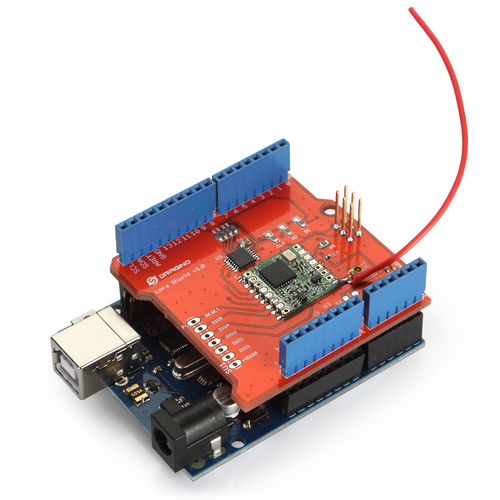Difference between revisions of "Lora Shield"
(→Hardware version info) |
(→Wireless Specifications of RFM95W) |
||
| Line 23: | Line 23: | ||
*Lora Shield v1.3: Remove 5v to 3.3v LDO, use 3.3 directly from Arduino +3.3v pin. | *Lora Shield v1.3: Remove 5v to 3.3v LDO, use 3.3 directly from Arduino +3.3v pin. | ||
| + | |||
| + | |||
| + | |||
=Wireless Specifications of RFM95W= | =Wireless Specifications of RFM95W= | ||
Revision as of 07:03, 31 May 2016
Contents
What is the Dragino Lora Shield
The Dragino Lora Shield is a long range transceiver on a Arduino shield form factor and based on Open source library.The Lora Shield allows the user to send data and reach extremely long ranges at low data-rates.It provides ultra-long range spread spectrum communication and high interference immunity whilst minimising current consumption.
The Lora Shield based on RFM95W/RFM98W targets professional wireless sensor network applications such as irrigation systems, smart metering, smart cities, smartphone detection, building automation, and so on.
Using Hope RF’s patented LoRaTM modulation technique the Lora Shield can achieve a sensitivity of over -148dBm using a low cost crystal and bill of materials. The high sensitivity combined with the integrated +20 dBm power amplifier yields industry leading link budget making it optimal for any application requiring range or robustness. LoRaTM also provides significant advantages in both blocking and selectivity over conventional modulation techniques, solving the traditional design compromise between range, interference immunity and energy consumption.
These devices also support high performance (G)FSK modes for systems including WMBus, IEEE802.15.4g. The Lora Shield deliver exceptional phase noise, selectivity, receiver linearity and IIP3 for significantly lower current consumption than competing devices.
Hardware version info
- Lora Shield v1.0: The first hardware release for the Lora Shield.
- Lora Shield v1.2: Connect the DIOs to Arduino IO. Change i-pex connector to SMA connector.
- Lora Shield v1.3: Remove 5v to 3.3v LDO, use 3.3 directly from Arduino +3.3v pin.
Wireless Specifications of RFM95W
- 168 dB maximum link budget.
- +20 dBm - 100 mW constant RF output vs.
- +14 dBm high efficiency PA.
- Programmable bit rate up to 300 kbps.
- High sensitivity: down to -148 dBm.
- Bullet-proof front end: IIP3 = -12.5 dBm.
- Excellent blocking immunity.
- Low RX current of 10.3 mA, 200 nA register retention.
- Fully integrated synthesizer with a resolution of 61 Hz.
- FSK, GFSK, MSK, GMSK, LoRaTM and OOK modulation.
- Built-in bit synchronizer for clock recovery.
- Preamble detection.
- 127 dB Dynamic Range RSSI.
- Automatic RF Sense and CAD with ultra-fast AFC.
- Packet engine up to 256 bytes with CRC.
- Built-in temperature sensor and low battery indicator.
Features
- Compatible with 3.3v or 5v I/O Arduino Board.
- Frequency Band: 868 MHZ/433 MHZ (Pre-configure in factory)
- Low power consumption
- External Antenna via I-Pex connector
Example1 -- Use with LMIC library for LoraWAN compatible
LMIC library is LoraWAN compatible. This demo include: How to use Lora Shield to set up single channel gateway for TTN network. How to use Lora Shield to set up a Lora Node. How is the communication between the Lora Node and Lora Gateway. The full instruction is in this link: [1]
Example2 -- Use the RadioHead Library With Arduino Boards
The RadioHead Library simplifies communication between the Arduino Board and the Lora Shield.We can find it here: http://www.airspayce.com/mikem/arduino/RadioHead/ To use it in your project you just have to copy it in your Arduino project folder (next to your main Arduino project file .ino).After putting the lIbrary in the right place, you have to also modify the frequency to the frequency you want to use, the position of this is setFrequency() in the file: arduino-xxx\libraries\RadioHead\RH_RF95.cpp; Then ,we can easily to use it to do some experimentation.
RadioHead Examples
In this example,we use two Lora Shields to transmit and receive signal,there are some project in the RadioHead Library,the operation is as follows: Connect two Lora Shields with Arduino board and connect them to computer via the USB cable; We used the Lora Shield+Arduino UNO as the server to transmit signal and the Lora Shield+Aduino MEGA2560 as the client to receive signal here.
Lora Shields and Arduino boards
Connect the Lora Shield and Arduino,and connect them to computer.
Connection
Open the IDE and choose the right example;
Choose the example
Configure the IDE settings and upload the two skteches to Aduino.
Configure the IDE settings of MEGA
Configure the IDE settings of UNO
After configure the IDE settings,upload the skteche to Aduino.Check the Serial Moniter and we can view the running result of the two boards.
Running result of MEGA
Running result of UNO
Usage Notice
You have to be aware that Radio link quality and performances are highly dependent of environment. Better performances can be reached with: Outdoor environment. No obstacles. No high level radio interferer in the ISM 868MHz band. At least 1 meter above the ground.
Radio performances are degraded with:
Obstacles: buildings, trees...
Inner buildings environments.
High ISM 868MHz band usage by other technologies.
Radio communication are usually killed with bad topographic conditions. It is usually not possible to communicate through a hill, even very small.
Order Infomation
Lora Shield 868: Load with RFM95W-868S2, support 868M frenquency Lora Shield 915: Load with RFM95W-915S2, support 915M frenquency Lora Shield 433: Load with RFM98W-433S2, support 433M frenquency
Schematic
Lora Shield Schematic Frequent Ask Questions (FAQs)
I have order Lora Shield v95-868, while the chip on lora shield shows RF96? The Lora Shield v95-868 is equied with HopeRF RFM95W-868-S2. This module has a mark RF96 on it. it doesn't mean the chip is RFM96w, but it means the chip is using the SX1276 chip. Mean While, The Lora Shield v95-915 S2 with mark RF96 on the IC. The Lora Shield v98-433 S2 with mark RF98 on the IC and use the sx1278 chip.


